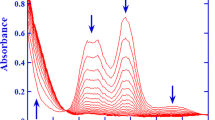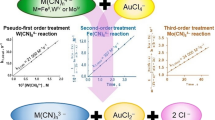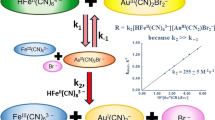Abstract
The oxidation of hydrazoic acid in perchloric acid in the absence of added chloride under pseudo first-order conditions ([HN3] » [AuCl −4 ]) is first order in [Au(III)]. Michaelis–Menten type of dependence (linear plots of k −1obs vs [HN3]−1) is observed with respect to [HN3]. The k obs is independent of ionic strength and the plot between k −1obs and [H+] is linear. The inner-sphere mechanism is consistent with the formation of an axial complex (K = 25 dm3 mol−1) between AuCl3(HO)− ion and HN3 prior to its rate determining decomposition (k = 0.0182 s−1). It is inferred that the free radicals N •3 do not oxidise Au(II). The reaction becomes outer-sphere in the presence of added Cl− ions which are inferred to form a cage around the hydronium ion surrounding the AuCl −4 ions. The penetration of N −3 through the cage is rate controlling and within the cage, the electron transfer from N −3 ion to AuCl −4 is fast. The value of the rate determining constant k 2 is 0.547 dm3 mol−1 s−1 and the equilibrium constant K Cl for the cage formation is 5 dm3 mol−1 at 25 °C. It is calculated that the minimum HN3 concentration required before the reaction exhibits zero-order dependence in HN3 is 0.31 mol dm−3 when [H+] = 0.18 mol dm−3 at 25 °C.









Similar content being viewed by others
Notes
The instrument having no facility for maintaining the constant temperature was not used for the kinetic study.
In making the calculations [Cl−] equal to the initial gold(III) complex is assumed to be present.
- $$ [\hbox{AuCl}_{3}(\hbox{H}_{2}\hbox{O})\hbox{N}_{3}^{-}] =\frac{KK_{\rm a}[\hbox{AuCl}_{3}(\hbox{H}_{2}\hbox{O})][\hbox{HN}_{3}]} {[\hbox{H}^{+}]}=\frac{K_1 K_{\rm H}[\hbox{AuCl}_{3}(\hbox{H}_{2} \hbox{O})][\hbox{HN}_{3}]}{[\hbox{H}^{+}]} $$
The rates reported for the corresponding reaction with IrCl 3−6 in [11] were measured at the Centre for Fast Kinetics Research at the University of Texas at Austin.
References
Audrieth LF (1934) Chem Rev 15:169
Evans BL, Yoffe AD, Gray P (1959) Chem Rev 59:515
Gray P (1963) Q Rev Chem Soc 17:441
Stedman G (1979) Adv Inorg Chem Radiochem 22:113
(a) Murmann RK, Sullivan JC, Thompson RC (1968) Inorg Chem 7:1876; (b) Wells CF, Mays D (1969) J Chem Soc A:2175; (c) Thompson RC, Sullivan JC (1970) Inorg Chem 9:1590
(a) Wells CF, Mays D (1968) J Chem Soc A:1622; (b) Davies G, Kirschenbaum LJ, Kustin K (1969) Inorg Chem 8:663; (c) Treindl CFL, Mrakova M (1977) Chem Zvesti 31:145
Heyward MP, Wells CF (1988) J Chem Soc Dalton Trans 1331
Suwyn MA, Hamm RE (1967) Inorg Chem 6:2150
Wells CF, Husain M (1969) J Chem Soc A:2981
Brown JK, Fox D, Heyward MP, Wells CF (1979) J Chem Soc Dalton Tran 735
Goyal B, Mehrotra M, Prakash A, Mehrotra RN (2000) Inorg React Mech 1:289
Borish ET, Kirschenbaum LJ (1984) Inorg Chem 23:2355
Sen Gupta KK, Sanyal A, Ghosh SP (1995) J Chem Soc Dalton Trans 1227
Bandyopadhyay P, Dhar BB, Bhattacharyya J, Mukhopadhyay S (2003) Eur J Inorg Chem 4308
Wilmarth WK, Stanbury DM, Byrd JE, Po HN, Chua C-P (1983) Coord Chem Rev 51:155
Ram MS, Stanbury DM (1986) J Phys Chem 90:3691
Marus RA (1963) J Phys Chem 67:853; (1964) Ann Rev Phys Chem 15:155; (1965) J Chem Phys 43:679
Soni V, Sindal RS, Mehrotra RN (2007) Inorg Chim Acta 360:3141
(a) Soni V, Mehrotra RN (2003) Transition Met Chem 28:893; (b) Sengupta KK, Basu B (1983) Transition Met Chem 8:6
Soni V, Sindal RS, Mehrotra RN (2005) Polyhedron 24:1167
Zou J, Guo Z, Parinson JA, Chen Y, Sadler PJ (1999) Chem Commun 1359
Drougge L, Elding LI (1987) Inorg Chem 26:1073
(a) Elding LI, Skibsted LH (1986) Inorg Chem 25:4084; (b) Elding LI, Olsson LF (1982) Inorg Chem 21:779
Ericson A, Arthur JC, Coleman RS, Elding LI, Elmorth SKC (1998) J Chem Soc Dalton Tran 1687
Ericson A, Elding LI, Elmorth SKC (1997) J Chem Soc Dalton Tran 1159
(a) Elmorth SKC, Elding LI (1996) Inorg Chem 35:2337; (b) Elmorth S, Skibsted LH, Elding LI (1989) Inorg Chem 28:2703
(a) Berglund J, Voigt R, Fronaeus S, Elding LI (1994) Inorg Chem 33:3346; (b) Sengupta KK, Sanyal A, Sen PK (1994) Transition Met Chem 19:534
Sengupta KK, Das S, Sen Gupta S (1988) Transition Met Chem 13:261
Sen Gupta KK, Basu B (1984) Polyhedron 3:805
Skibsted LH (1986) Adv Inorg Bioinorg Mech 4:137
References 3–15 in Ref. 21.
Cotton FA, Wilkinson G (1986) Advanced inorganic chemistry, 3rd edn. Wiley Eastern. New Delhi, p 353
Fry FH, Hamilton GA, Turkevich J (1966) Inorg Chem 5:1943
Rekha Ms, Prakash A, Mehrotra RN (1991) Can J Chem 71:2164
Seddon EA, Seddon KR (1984) The chemistry of ruthenium. Elsevier, p 251
Feigl F, Anger V, Oesper R (1972) Spot tests in inorganic analysis, 6th English edn. Elsevier Amsterdam, p 241
Martell AE, Smith RM (1989) Critical stability constants, vol 4. Plenum, New York, p 45
Robb W (1967) Inorg Chem 6:382
Peshchevitskii BI, Belevantsev VI, Kurbatova NV (1971) Russ J Inorg Chem (Engl Transl) 16:1007
Cattalini L, Tobe ML (1966) Coord Chem Rev 1:106
Volger A, Wright RE, Kunkley H (1980) Angew Chem Int Ed Engl 19:717
Mehrotra RN, Kirschenbaum LJ (1989) Inorg Chem 28:4327
Kouadio I, Kirschenbaum LJ, Mehrotra RN (1990) J Chem Soc Dalton Trans 1929
Kouadio I, Kirschenbaum LJ, Mehrotra RN, Sun Y (1990) J Chem Soc Dalton Trans 2123
Berglund J, Elding LI (1995) Inorg Chem 34:513
Cattalini L, Marangoni G, Paolucci G, Pitteri B, Tobe ML (1987) Inorg Chem 26:2450
Refs. 17(b) and 26
(a) Sen Gupta KK, Basu B, Sen Gupta S, Nandi S (1983) Polyhedron 2:983; (b) Ref. 27
Sen Gupta KK, Maiti S, Ghosh SP (1980) Indian J Chem 19(A):869
Brown A, Higginson WCE (1972) J Chem Soc Dalton Trans 166
Foresberg HG, Widdel H, Erwall LG (1960) J Chem Educ 37:44
Basalo F, Pearson RG (1977) Mechanism of inorganic reactions, 2nd edn. Wiley Eastern, New Delhi, p 414
Ref. 30, p 1044
Latimer WM (1953) The oxidation states of the elements and their potentials in aqueous solutions, 2nd edn. Prentice-Hall, p 197
Butler J, Land EJ, Swallow AJ, Pritz W (1984) Radiat Phys Chem 23:65
Acknowledgements
Thanks are due to the UGC, F.12-59/1997 and F.12-147/2001, for the financial support of the work. Thanks are also due to Kriti Mehrotra, my grand daughter, at Cornell University, in helping with certain references.
Author information
Authors and Affiliations
Corresponding author
Rights and permissions
About this article
Cite this article
Soni, V., Mehrotra, R.N. Mechanism of the oxidation of hydrazoic acid by tetrachloroaurate(III) ion. Transition Met Chem 33, 367–376 (2008). https://doi.org/10.1007/s11243-007-9052-9
Received:
Accepted:
Published:
Issue Date:
DOI: https://doi.org/10.1007/s11243-007-9052-9




